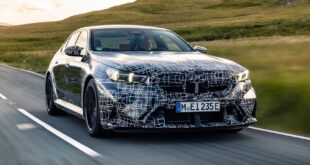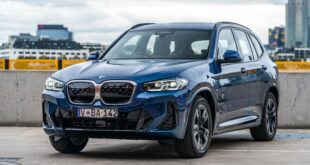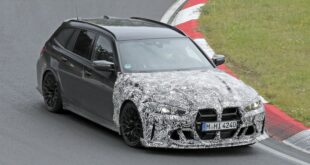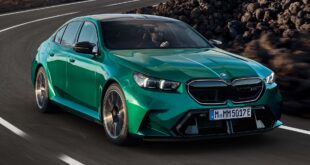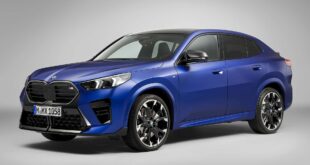 After the international press launch, reviews of the 2011 BMW X3 from automobile journalists start to roll in. Here are some excerpts from various reviews:
After the international press launch, reviews of the 2011 BMW X3 from automobile journalists start to roll in. Here are some excerpts from various reviews:
The new X3’s stylistic huevos find an equally energetic counterpart in the engine bay. While the base xDrive28i 3.0-liter inline-6 has a perfectly respectable 240 bhp, the top model that we drove—the xDrive35i—has the N55 3.0-liter direct-injected turbocharged six that packs a lusty 300 bhp, a significant 40-bhp increase from its predecessor’s top engine. Each is paired with an all-new 8-speed automatic (which weighs no more than the 6-speed it replaces) and coupled to standard all-wheel-drive system whose center electronically controlled multiplate clutch normally apportions torque in a 40/60 front/rear ratio, yet can send 100 percent to the rear axle in certain cornering situations.
Suspension is new as well, the rear 5-link setup derived from the 3 Series line, while the front MacPherson-strut suspension eschews the “boomerang†lower control arms for independently jointed links, for both a tighter turning radius and better steering axis geometry.
Our test vehicles were loaded with options, including Electronic Damping Control with Normal, Sport and Sport + modes, which includes what’s called the Performance Control feature that helps turn-in and cornering balance by applying the inside rear brake while simultaneously applying extra power to overcome the brake drag.
So how does it all work? In a word, satisfying. BMW claims a 0–60 lunge of just 5.5 seconds, which is entirely believable. The new 8-speed is a jewel…when in Sport + mode and shifted via the optional steering-wheel paddles, the response times are gratifyingly quick. The new Servotronic electric-assist steering feels natural and well-weighted; while it falls short of 3 Series levels of communication, it’s excellent for the class. Given the vehicle’s height, body roll is extremely well controlled, and even in Sport + mode, the X3 lacks the primary-ride impact harshness of its predecessor, and feels downright comfortable in Normal. Big 245/50R-18 Pirelli P Zeros complement the chassis’ tidy handling with sport sedan levels of grip.
BMW offered up a moderately easy off-road drive of the twin-turbocharged xDrive 35i at a farm outside Atlanta. The X3 was as quiet as could be on the mostly gravel, red clay road, and nicely demonstrated its long suspension travel over a few severe bumps. It proved you’ll be comfortable driving the X3 to your remote second home in the woods, and you probably won’t need the hill descent control at all, unless you need to roll down steep hills at 5 mph.
There were no turns on the mildly twisty two-lane nearby that were tight enough to trigger the DSC. The drive only proved that the new X3 is nicely controlled, and that whatever tradeoff was made in handling is worth the silky ride. The electronically assisted power steering isn’t up to BMW’s best steering. It increases weight at higher speeds, making it easy to keep the tall vehicle centered on the highway, though the weight feels artificial, and the steering doesn’t give you much road surface information.
Switch to the Sport mode and the eight-speed’s super-smooth shifts become sharp, even a bit jarring. The twin-turbo’s raspy note is wonderful under hard acceleration, and if nothing else, the engine’s ability to motivate the two-ton crossover will remind you of which brand you’ve chosen.
After BMW’s misstep with the first X3, it’s back on track with an X3 that combines compact crossover convenience and versatility with much of the goodness of the car that remains the brand’s best model, the 3 Series.
In an era of general economic gloom, the new X3’s pricing looms as a bright spot. When it goes on sale in late December, the basic version—officially badged X3 xDrive28i—will start at $37,625. That’s $2100 less than its predecessor, and includes more standard equipment, including iPod and USB interfaces, Bluetooth connectivity, and an anti-theft alarm. The turbo X3 xDrive35i will start at $41,925, and adaptive xenon headlights are among the additional standard equipment.
We don’t have detailed option pricing at this point, but we do know there are several choices new to the X3. For example, the second-row seat can be ordered in a 40/20/40 split, providing more cargo flexibility. BMW’s head-up display also will be on the options list for the first time, the ConnectedDrive package includes a very clear backup camera as well as an around-view system, the nav setup incorporates a text-to-speech function for text messages and e-mail, and the Dynamic Handling package includes BMW’s variable sport steering.
A couple things missing from the U.S. options list are BMW’s excellent 3.0-liter turbo-diesel, which will be offered initially only in other markets. Already available here in the X5 and 3-series sedan, it may find its way into the X3 at some later date. Also missing, for now, is a new engine stop/start feature to save fuel when the car is at stoplights. This, too, will be offered at launch elsewhere.
The first thing you notice is the transformed interior.
The new cabin is much more what you’d expect of a premium car maker like BMW, with quality materials (a match for the 3-series), a generous standard spec and an ultra-clean layout.
The increase in the car’s size has resulted in usefully more cabin space than before, especially in the rear, where there’s now enough leg, shoulder and elbow room for two 6ft-plus adults to sit in comfort.
Getting in and out of the rear doors is much easier than it used to be, too, while the luggage bay is now the biggest in the class (with a capacity of 550-1600 litres) and the rear seats split 40/20/40 and fold almost flat, making the X3 a lot more practical than it was before.
BMW’s 2.0-litre, four-cylinder turbodiesel engine is as impressive in practice as it is on paper.
In the new X3 it produces 181bhp and 280lb ft of torque – increases of four and nine per cent respectively over its predecessor.
Not only is it gutsy and refined, but it’s also the most efficient unit in its class, with combined economy of 50.4mpg and CO2 emissions of 149g/km in manual form – respectively 14 per cent and 15 per cent better than the old X3.
The eight-speed auto version has identical performance and economy figures and actually produces slightly less CO2 (147g/km).
The introduction of Dynamic Drive Control and electronically controlled dampers means X3 occupants no longer have to live with a stiff ride.
The new X3 may be a little less agile than the outgoing one, but its ride is relatively supple, even in the sportier settings, which tighten up body control sufficiently for the X3 to still handle with a great deal of composure.
The new electric power steering, though short on feel, is pleasingly meaty in weight, too.
The only real problem from the driver’s point of view is that the manual shift is quite obstructive; the new auto will be the more appealing option for many.
Should I buy one?
With all of the flaws rectified, the new X3 is a big improvement on its predecessor and in most quantifiable ways is now a front-runner in this class, easily capable of going head to head with the likes of the Audi Q5 and Land Rover Freelander SD4.
It’s taken seven years, but the X3 is now a car we can heartily recommend.
 BMW.SG | BMW Singapore Owners Community The Ultimate BMW Community – Established Since 2001
BMW.SG | BMW Singapore Owners Community The Ultimate BMW Community – Established Since 2001






